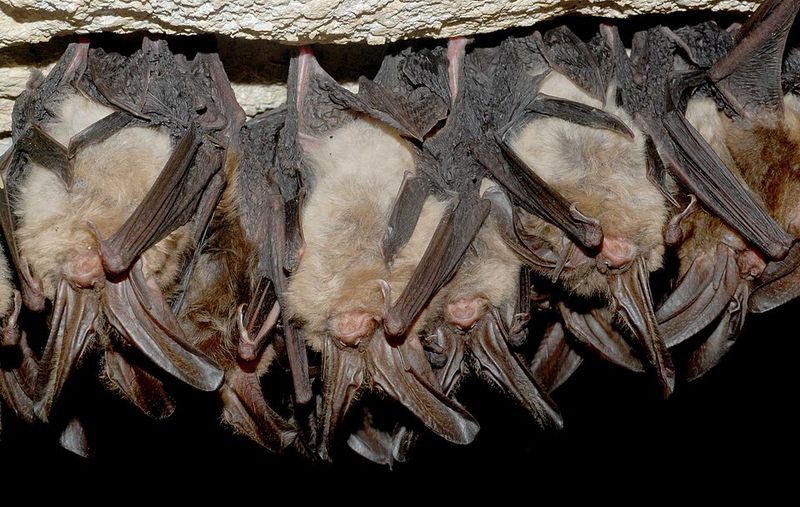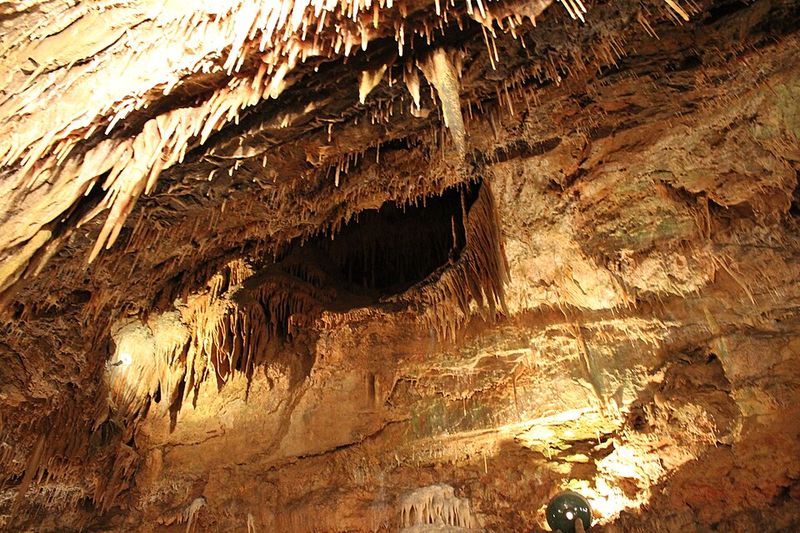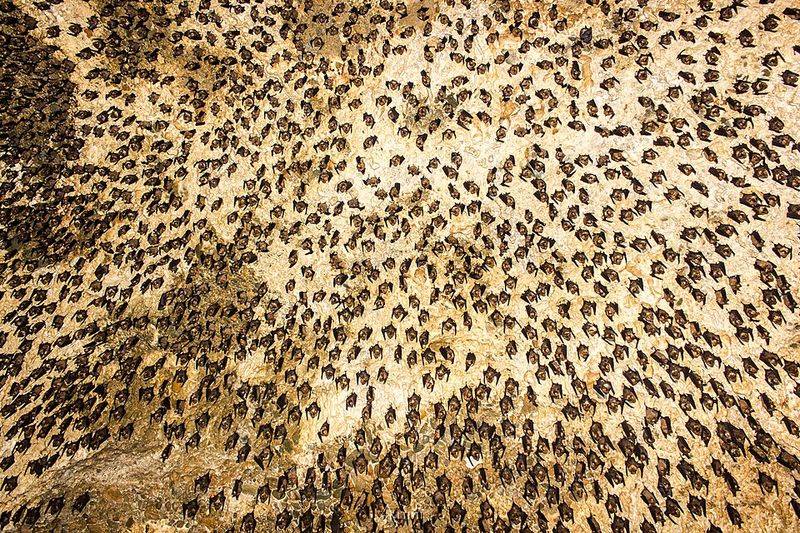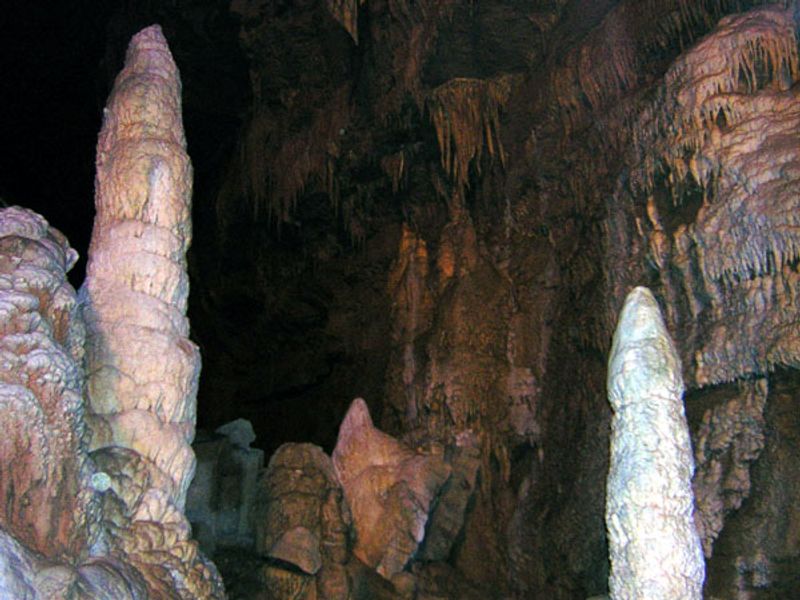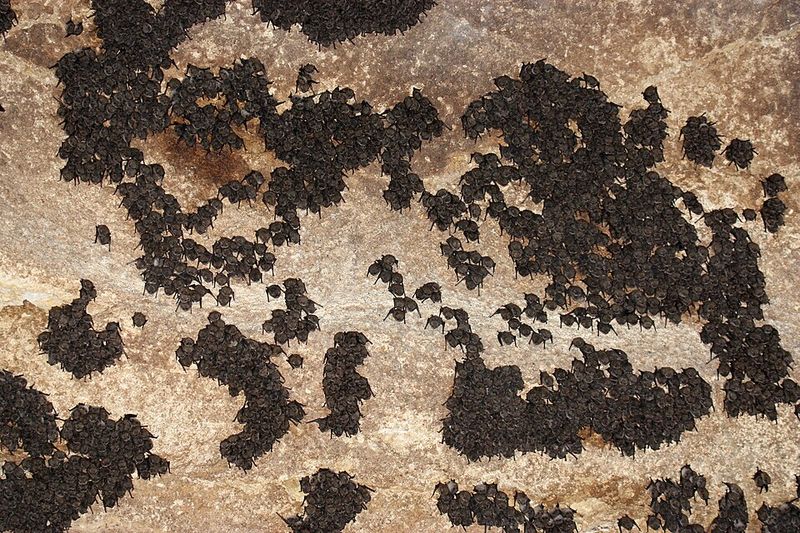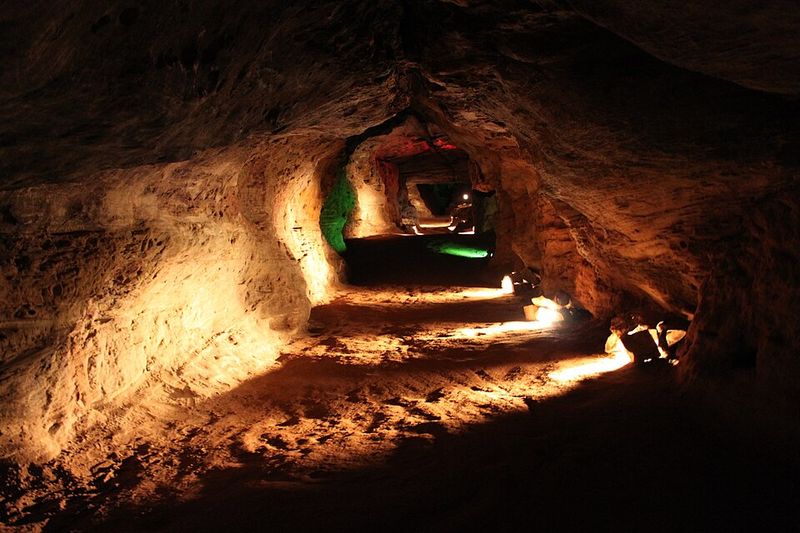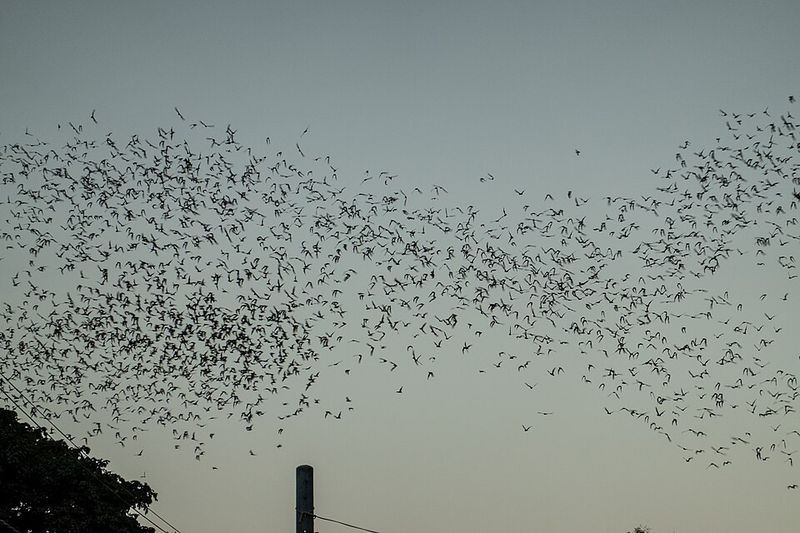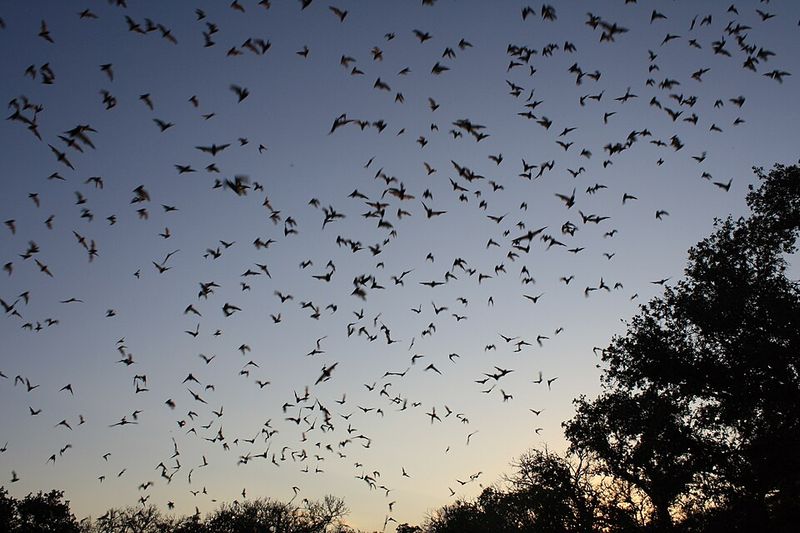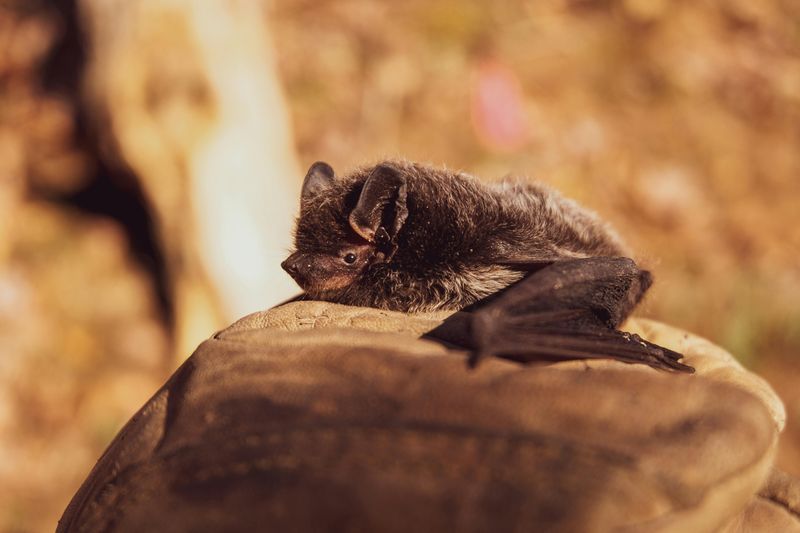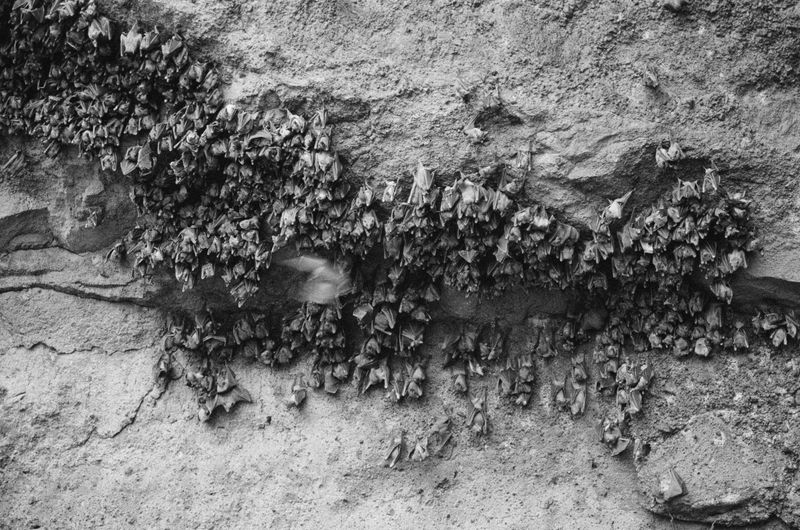Do tight tunnels, echoing drips, and the rush of unseen wings make your heart race? West Virginia’s bat caves are equal parts natural wonder and nerve test, where narrow squeezes and shadowed chambers challenge even seasoned cavers. These subterranean sanctuaries also shelter endangered species, demanding respect and caution from every visitor. Ready to crawl into the dark and feel the mountain breathe around you?
1. Hellhole Cave (Germany Valley)
Hellhole is a vertical abyss that feels alive, exhaling cold breath from its 154-foot entrance drop. Beyond the rigging, passageways labyrinth into 43.6 miles of darkness, pierced only by cautious lamp beams. The chambers are vast yet often accessed through unnervingly tight crawls that squeeze confidence from even veteran cavers. It’s a winter fortress for endangered bats, including the Virginia big-eared, demanding strict seasonal closures and quiet discipline. Your reward is the humbling sense of geological cathedral space, where dripping calcite ticks time. Claustrophobes beware: the commitment is absolute – once you’re in, the mountain holds you.
2. Smoke Hole Caverns (near Petersburg)
Smoke Hole Caverns lures visitors with shimmering formations, only to funnel them into tight corridors that press shoulders and nerves. The famed ribbon stalactite hangs like a curled banner, delicate yet imposing. Even in tour lighting, bends and low ceilings conspire to unsettle, swallowing sound in mineral hush. The air stays cool and damp, magnifying every breath. Claustrophobes may find their pulse racing as passages narrow unexpectedly. Yet beauty thrives in the squeeze – rippling flowstone and needle-thin soda straws reward steady steps. Respect posted routes, mind your headlamp, and let the cave’s ancient silence guide you onward.
3. Higginbotham Cave System (Greenbrier County)
Hidden beneath the Davis Spring Basin, Higginbotham is wild, muddy, and unapologetically tight. Its passages demand belly crawls, awkward contortions, and calm breathing when rock grazes your ribs. Access is restricted to protect delicate ecosystems and hibernating bats, which means timing and permitting matter. Inside, tiny pools mirror trembling light while breakdown piles create claustrophobic choke points. This isn’t show cave country – expect route-finding, teamwork, and low ceilings that test composure. In winter, the cave transforms into a quiet refuge for endangered species, and humans must yield. For serious cavers, its challenge is its calling card.
4. Sinnett-Thorn Mountain Cave System
Sinnett-Thorn is a living nursery for bats, and the cave’s first rule is hush. Sound and light discipline are essential as you thread narrow slots and stoop through constricted crawls. The sense of enclosure amplifies every drip and heartbeat, turning movement into meditation. Fragile formations glimmer where condensation gathers and microclimates shelter roosts. Claustrophobia flares in squeeze points that demand slow, deliberate progress. Access can be limited seasonally to protect hibernating colonies. When permitted, experienced teams step lightly, leaving only footprints and quiet awe. The cave’s true treasure is its thriving, winged community.
5. Lost World Caverns (Lewisburg)
Lost World Caverns welcomes with a grand chamber, but veers into passages that compress perspective and courage. Tour paths showcase colossal stalactites and rippled flowstone while side corridors tease darker, tighter mysteries. The air is cool, the echo patient, and occasional low ceilings sharpen awareness of every step. Claustrophobes may feel the squeeze when walls lean in, especially beyond the most open spaces. Guides share geology and conservation practices, underscoring respect for bat habitats. It’s a rare blend: accessible wonder edging into true subterranean tension. Look up, breathe slow, and let the cave’s age calm your nerves.
6. Bone-Norman Cave System (Greenbrier County)
Bone-Norman is a maze demanding memory, maps, and measured breathing. Tight crawls connect to winding corridors where a wrong turn stretches nerves and time. The rock is close, the mud persistent, and bats choose the calmest ceilings. Expect route-finding savvy and composure when the ceiling drops to helmet-scrape height. Silence amplifies each scrape and drip, framing a world of slow water and limestone. Conservation protocols protect roosts and fragile formations, so tread lightly and avoid winter disturbances. This system rewards disciplined teams who balance curiosity with caution. For claustrophobes, the cumulative tightness is a stern test.
7. Laurel Caverns (near WV border) – WV Side Excursions
Though best known in Pennsylvania, Laurel Caverns anchors regional karst adventures that spill toward West Virginia’s border. Side excursions and nearby wild caves offer the same claustrophobic signatures: shoulder-brushing walls, knee-wrecking crawls, and sudden drops into black. The atmosphere is humid, the acoustics close, and bat-friendly etiquette is essential year-round. Expect controlled lighting, careful rigging, and slow passage through constrictions. Instructors often emphasize psychological pacing – steady breath, steady steps. Conservation rules may limit seasonal access to protect hibernating species. If you crave that heart-thrum of tight stone around you, these borderland routes deliver discreet, serious challenges.
8. Organ Cave (Greenbrier County)
Organ Cave blends Civil War lore with subterranean gravity, its aptly named formations looming like stone pipes. While some sections feel broad, the intrigue lies in side tunnels where ceilings drop and walls nip at elbows. The damp air carries mineral scent and subtle echoes of dripping water. Bats occasionally claim the calmer recesses, reinforcing quiet passage and strict seasonal closures. Guides spotlight geology and history, but wild segments demand calm in restricted space. Claustrophobes may feel pressure as sightlines vanish around corners. The cave’s layered stories – and strata – reward patience, care, and a deep respect for living darkness.
9. New Trout Cave (Pendleton County)
New Trout Cave feels intimate from the first stoop-walk, with ceilings that insist on humility. Breakdown piles create puzzles of balance while shallow pools mirror swaying beams. Survey marks hint at complex networks beyond, where crawls compress time and space. Bats claim quiet ledges; their presence guides respectful pacing and minimal noise. Claustrophobia can surge at squeeze points, but methodical movement keeps panic at bay. Seasonally restricted access protects hibernacula, so plan carefully. For those who crave the raw feel of wild karst, New Trout delivers authentic challenge – tight, damp, and resolutely beautiful.
10. Hancock Cave (Monroe/Greenbrier area)
Hancock is a practice in patience where mud, elbows, and stone engage in constant negotiation. Corridors narrow quickly, forcing crawls that graze forearms and test breathing rhythm. Minor drops demand careful footing and teamwork as lights glance off damp limestone. Bat roosts tucked into crevices remind you to move quietly, avoiding winter disturbances. This cave’s thrill isn’t grand vistas but the visceral immediacy of close rock and close decisions. If confined spaces tighten your chest, Hancock will find the limits. Preparation, communication, and respect for conservation protocols are your best allies underground.
11. Cass Cave (Pocahontas County)
Cass Cave is legend for its vertical drama, but the approach passages are where claustrophobia first whispers. Tight traverses funnel into rigging points above echoing voids and misted waterfall pits. The air cools to a shiver, and limestone glows under concentrated beams. Bats sometimes drift along the periphery, urging quiet discipline. This is technical ground: ropes, redundancy, and practiced teams are nonnegotiable. Seasonal closures protect hibernating populations; always verify access. The payoff is a symphony of water, stone, and courage, composed in darkness. Every move here is deliberate – and unforgettable.
12. Scott Hollow Cave (Monroe County)
Scott Hollow blends soothing stream walks with claustrophobic interludes that reset your breath. Low ceilings force stoops that creep into crawls, where knees meet cold stone. Pools reflect fragile formations while quiet bats rest beyond the main path. Expect route-finding choices and a steady cadence, especially when water narrows the way. Conservation rules prioritize minimal impact and seasonal protection, so plan with care. The cave rewards composure: calm lights, calm steps, calm voice. You’ll emerge with mud-slick gear and a hard-won appreciation for the cave’s living rhythm.
13. Hamilton Cave (Lost River State Park)
Hamilton Cave sits within Lost River State Park, inviting exploration that quickly tightens in tone and space. Beyond the entrance, corridors pinch to narrow slots lined with damp stone and delicate draperies. Guides emphasize conservation – especially around bat roosts – and the importance of steady, low-key movement. Claustrophobes may feel the squeeze where ceilings drop and walls converge. The cave’s quiet is immersive, turning every footfall into a measured note. Seasonal policies may limit access to protect hibernating species. Approach with humility, and the cave reveals subtle textures and the calm presence of its winged residents.

